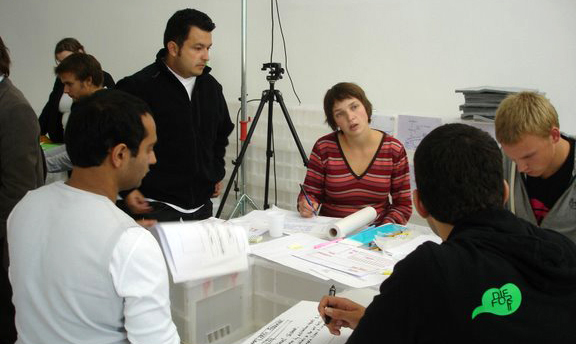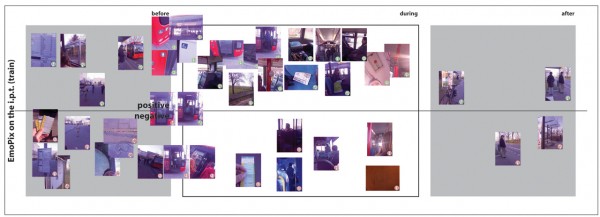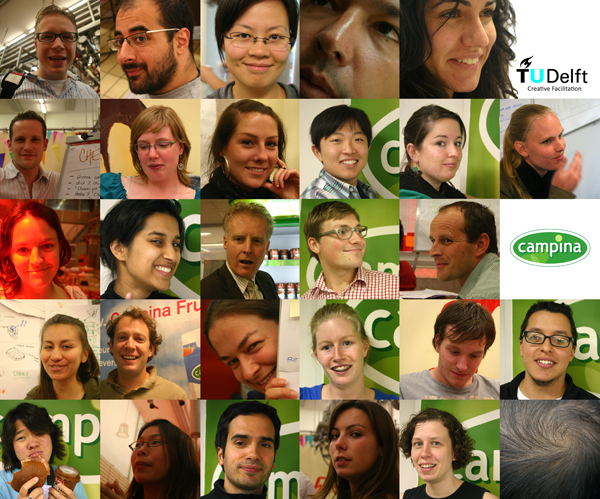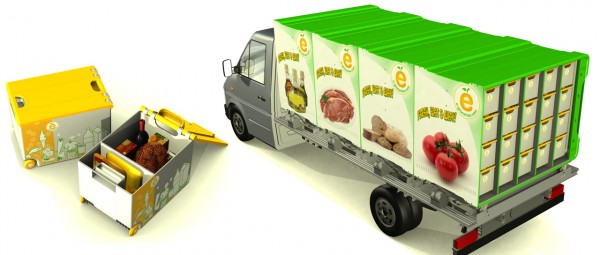Blog
Context mapping (part 1): Observation
EmoPix (Susa group ®)
Thanks to a graduation project called “Developing a Tool to Assess Emotions Elicited by Services” by David Güiza Caicedo (TUDelft 2009) was possible used a handheld with an EmoPix (Güiza Caicedo, 2009) tool to ask three participants about their impressions and emotions related to public buses in The Netherlands.
By using a handheld device with a built-in camera, a user can take pictures of different places, situations or things and add an emotional tag to them via a button (either physical or display based) depicting one of the available emotions. This way, the user can identify the stimuli by simply taking a photograph of them. In the end of the journey, the device was collected and the pictures were used to generate different sorts of visual collages, such as clustering them by location or by emotion, or building an emotional storyboard of the user’s experience throughout the time of his trip.
Creative session (part 2): Future faculty workshop
After the fire in the Architectural building (TUDelft 2008) the association of students Stylos[1] arranged two activities in order to progress in the International competition to design the new building of the faculty. The starting point was the kickoff of the competition at Delft, including creative sessions to create the basic concept for the competition. After that the association arranged the international creative session in the 11 Mostra Internazionale di Architettura, La Biennale di Venezia at Venice, Italy.
International creative session in the 11 Mostra Internazionale di Architettura.
 Name: Concept for the new Faculty of Architecture TUDelft.
Name: Concept for the new Faculty of Architecture TUDelft.
Date: 11/09/2008 till 13/09/2008.
Duration: 3 days.
Place: 11 Mostra Internazionale di Architettura, La Biennale di Venezia at Venice, Italy.
Leader (facilitator): Ricardo Mejia S.
Client: Academic Stylos / Faculty of Architecture TUDelft.
Problem owner: Faculty of Architecture TUDelft.
Participants: not available.
Consultancy (part 1): Ergo-ecology and other technicalities…
This project is an interesting example of cooperation between the University and industries in Latin America. The research project was conducted in the Industrial Design Department at the Pontificia Universidad Javeriana in Bogota Colombia. The concept of Ergoecology (G.García, P.Romero, & M.H.Saravia, 1997) was developed as a proposal to integrate evaluation and intervention processes generally used in ergonomics and environmental management systems. Ergoecology, as scientific and technological discipline, looks forward ”-from a systemic focus-, to take care of studying the human being and its relationships with the environment -through its activities (work)- to establish, analyze, reduce, prevent, control and rectify the impacts (positives and negatives) that derive from such a relationship”.
Creative session (part 3): Campina
Creative Facilitation is about setting up and leading creative processes in product innovation teams[1]. The course Creative Facilitation contents describe the role of the facilitator as a leader of a creative team during a “Creative Session” in order to achieve a specific goal. For that process the course provides some theoretical reflections, including lectures, readers and discussions about techniques of design, lead and participate in creative processes.
Starting with theory, the course moved into guided exercises which gradually grow in complexity and scope (Delft University of Technology, 2007). Including other activities in the end of the course the student has a totally of two creative sessions, one as an internal session and the other as an external one. In my particular case I had a previous experience using some basic methods of creativity, like brainstorming and lateral thinking, including mind maps and some ice breakers but the course was an excellent exercise to grow in the comprehension of how this methods and other more can improve the quality of the new product development processes.
[nggallery id=11]
[1] (Delft University of Technology, 2007)
Javier Ricardo Mejia Sarmiento
Case Study 1: From A to green a future vision of coachworks
“The connection between Combigroep’s brand image and brand identity through a product”
Facts
Client: COMBIGROEP CARROSSERIEËN
Design & Engineering: Rodrigues Santos A., Vrijling B., Mejia J.R. (Strategic design & team leader), Güiza Caicedo D., van Houten M., and Heru Prabowo S.
Project date & place: 2008 – 2009 The Netherlands.
Overview
The project engages sustainability and innovation in an effort to provide a significant step-up on the connection between Combigroep’s brand image and brand identity through a product. The team intended to make a creative exercise by projecting a future vision that finally inspired a realistic and influential product – an environmentally friendly and versatile coachwork.



